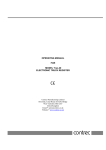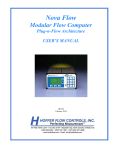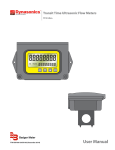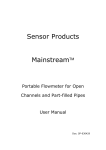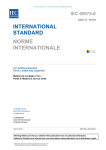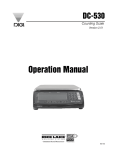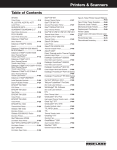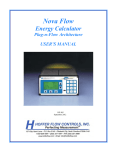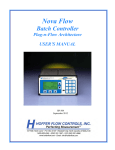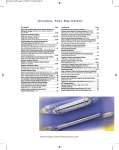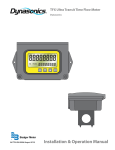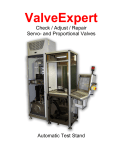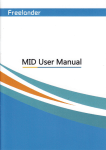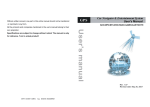Download 205D-L MAN_Nov02.DOC - Hoffer Flow Controls, Inc
Transcript
MODEL 205D-L Flow Computer USER’S MANUAL HP-299 November 2002 107 Kitty Hawk Lane, P.O. Box 2145, Elizabeth City, NC 27906-2145 800-628-4584 252-331-1997 FAX 252-331-2886 www.hofferflow.com E-mail: [email protected] NOTICE Hoffer Flow Controls, Inc. makes no warranty of any kind with regard to this material, including, but not limited to, the implied warranties of merchantability and fitness for a particular purpose. This manual has been provided as an aid in installing, connecting, calibrating, operating, and servicing this unit. Every precaution for accuracy has been taken in the preparation of this manual; however, Hoffer Flow Controls, Inc. neither assumes responsibility for any omissions or errors that may appear nor assumes liability for any damages that result from the use of the products in accordance with information contained in the manual. HOFFER FLOW CONTROLS' policy is to provide a user manual for each item supplied. Therefore, all applicable user manuals should be examined before attempting to install or otherwise connect a number of related subsystems. During installation, care must be taken to select the correct interconnecting wiring drawing. The choice of an incorrect connection drawing may result in damage to the system and/or one of the components. Please review the complete model number of each item to be connected and locate the appropriate manual(s) and/or drawing(s). Identify all model numbers exactly before making any connections. A number of options and accessories may be added to the main instrument, which are not shown on the basic user wiring. Consult the appropriate option or accessory user manual before connecting it to the system. In many cases, a system wiring drawing is available and may be requested from Hoffer Flow Controls. This document contains proprietary information, which is protected by copyright. All rights are reserved. No part of this document may be photocopied, reproduced, or translated to another language without the prior written consent of Hoffer Flow Controls, Inc. HOFFER FLOW CONTROLS’ policy is to make running changes, not model changes, whenever an improvement is possible. This affords our customers the latest in technology and engineering. The information contained in this document is subject to change without notice. THIS WARRANTY IS EXPRESSLY IN LIEU OF ALL OTHER WARRANTIES, EXPRESSED OR IMPLIED, INCLUDING ANY IMPLIED WARRANTY OF MERCHANTABILITY OR FITNESS FOR A PARTICULAR PURPOSE. HFC SHALL NOT BE LIABLE FOR ANY LOSS OR DAMAGE RESULTING, DIRECTLY OR INDIRECTLY, FROM THE USE OR LOSS OF USE OF THE GOODS. WITHOUT LIMITING THE GENERALITY OF THE FOREGOING, THIS EXCLUSION FROM LIABILITY EMBRACES THE PURCHASER'S EXPENSES FOR DOWNTIME OR FOR MAKING UP DOWNTIME, DAMAGES FOR WHICH THE PURCHASER MAY BE LIABLE TO OTHER PERSONS, DAMAGES TO PROPERTY, AND INJURY TO OR DEATH OF ANY PERSONS. HFC NEITHER ASSUMES NOR AUTHORIZES ANY PERSON TO ASSUME FOR IT ANY OTHER LIABILITY IN CONNECTION WITH THE SALE OR USE OF HFC'S GOODS, AND THERE ARE NO ORAL AGREEMENTS OR WARRANTIES COLLATERAL TO OR AFFECTING THE AGREEMENT. PURCHASER'S SOLE AND EXCLUSIVE REMEDY IS THE REPAIR AND/OR REPLACEMENT OF NONCONFORMING GOODS AS PROVIDED IN THE PRECEDING PARAGRAPHS. HFC SHALL NOT BE LIABLE FOR ANY OTHER DAMAGES WHATSOEVER INCLUDING INDIRECT, INCIDENTAL, OR CONSEQUENTIALDAMAGES. HFC 9907 Limited Warranty POLICY FOR Hoffer Flow Controls HOFFER FLOW CONTROLS, INC. ("HFC") warrants HFC's Precision Series and API Series of turbine flowmeters to be free from defects in material and workmanship under normal use and service, only if such goods have been properly selected for the service intended, properly installed and properly operated and maintained as described in the turbine flowmeter manual. Reference "turbine flowmeter manual" for specific details. This warranty shall extend for a period of five (5) years from the date of shipment to the original purchaser and covers the Precision Series and API Series of flowmeters All other HFC products carry a one (1) year warranty. This warranty is extended only to the original purchaser ("Purchaser"). Purchaser's sole and exclusive remedy is the repair and/or replacement of nonconforming goods as provided in the following paragraphs. In the event Purchaser believes the Hoffer product is defective, the product must be returned to HFC, transportation prepaid by Purchaser, within the appropriate warranty period relative to the product. If HFC's inspection determines that the workmanship or materials are defective and the required maintenance has been performed and, has been properly installed and operated, the product will be either repaired or replaced, at HFC's sole determination, free of additional charge, and the goods will be returned, transportation paid by HFC, using a transportation method selected by HFC. Prior to returning the product to HFC, Purchaser must obtain a Returned Material Authorization (RMA) Number from HFC's Customer Service Department within 30 days after discovery of a purported breach of warranty, but not later than the warranty period; otherwise, such claims shall be deemed waived. See the Return Requests/inquiries Section of this manual. If HFC's inspection reveals the Hoffer product to be free of defects in material and workmanship or such inspection reveals the goods were improperly used, improperly installed, and/or improperly selected for service intended, HFC will notify the purchaser in writing and will deliver the goods back to Purchaser upon receipt of Purchaser's written instructions and agreement to pay the cost of transportation. If Purchaser does not respond within thirty (30) days after notice from HFC, the goods will be disposed of in HFC's discretion. HFC does not warrant the product to meet the requirements of any safety code of any state, municipality, or other jurisdiction, and Purchaser assumes all risk and liability whatsoever resulting from the use thereof, whether used singlely or in combination with other machines or apparatus. This warranty shall not apply to any HFC product or parts thereof, which have been repaired outside HFC's factory or altered in any way, or have been subject to misuse, negligence, or accident, or have not been operated in accordance with HFC's printed instructions or have been operated under conditions more severe than, or otherwise exceeding, those set forth in the specifications. FOR NON-WARRANTY REPAIRS OR CALIBRATIONS, consult HOFFER FLOW CONTROLS for current repair/calibration charges. Have the following information available BEFORE contacting HOFFER FLOW CONTROLS: 1. P.O. number to cover the COST of the repair/calibration, 2. Model and serial number of the product, and 3. Repair instructions and/or specific problems relative to the product. HFC 9907 CONTENTS 1. Introduction 1 1.1 Model Number Designation ........................................................ 3 2. Specification 4 3. Operation 7 3.1 Front Panel Operation ................................................................. 9 3.2 Single and Quadrature Inputs .................................................... 11 3.3 Calculation of Rate and Total.................................................... 12 3.3.1 Frequency Input ...........................................................12 3.3.2 Analog Input ................................................................13 3.3.3 Filtering........................................................................14 3.4 Total Conversion....................................................................... 16 3.5 Non-Linearity Correction.......................................................... 17 3.6 The Output Pulse and Flow Alarm............................................ 19 4. Temperature Compensation 21 4.1 Temperature Input (RTD OR 4-20mA)..................................... 22 4.1.1 RTD Input ....................................................................22 4.1.2 4-20mA ........................................................................22 4.2 Volume Correction for General Liquids ................................... 23 4.3 Density Correction for General Liquids.................................... 25 4.3.1 Volumetric Flowmeters................................................25 4.3.2 Differential Pressure Devices.......................................26 4.4 Compensation for Petroleum Liquids........................................ 27 4.5 Compensation for Liquefied Petroleum Gas (LPG) .................. 29 4.6 Density Meter Input .................................................................. 30 5. Options 31 5.1 The 4-20mA Output Option ...................................................... 31 5.1.1 Load Specification .......................................................32 5.1.2 Calculation ...................................................................32 5.2 The RS232/422/485 Interface Option ....................................... 35 5.2.1 Hardware......................................................................35 5.2.2 Multipoint Communication..........................................36 5.2.3 Communication Protocol .............................................38 5.3 The Relay Output Option .......................................................... 40 Model 205D-L HP-299 6. Configuration 41 6.1 Configuring the Setup Parameters............................................. 43 6.2 Configuring the Options............................................................ 49 6.3 Checking the Input Signal ......................................................... 52 7. Input Circuits 54 7.1 Flow Inputs ............................................................................... 54 7.1.1 Frequency Inputs..........................................................54 7.1.2 Analog Flow Input .......................................................60 7.2 Temperature or Density Input ................................................... 61 8. Installation 63 8.1 General ...................................................................................... 63 8.2 Terminal Wiring Designations .................................................. 65 9. Trouble Shooting 66 9.1 Error Codes ............................................................................... 66 Model 205D-L HP-299 Introduction 1 1. Introduction The Model 205D-L Flow Computers use temperature correction to calculate the volumetric flow for liquids at standard reference conditions. This manual covers the Model 205D-L series which accepts most frequency and pulse signals, including mV outputs from turbine flowmeters and two wire proximity switch outputs. The instrument is fully configurable, with all calculation constants set via the front panel switches and stored permanently in a non-volatile memory. Mass flow can also be calculated from the temperature input and the volumetric flow input. Therefore, the Model 205D-L series Flow Computer will enable relatively low cost mass flow measurement using positive displacement or turbine flowmeters and an RTD. The Model 205D-L is ideally suited to custody transfer applications and includes the API/ASTM equations covering general petroleum products and LPG. Quadrature signal inputs are provided, where it is required to ensure the integrity of the flow signal, or to measure bidirectional flow. Two versions of the instrument are available; the Model 205D-LR with direct RTD input and the Model 205D-LA with a 4-20mA temperature input. Both offer the following temperature compensation: 1. Density Correction A five point temperature-density curve can be programmed, and the MASS flow calculated. 2. Volume Correction for General Liquids The thermal Coefficient of Expansion of the liquid can be programmed and a reference temperature defined for volume correction to that reference. 3. Petroleums Volumetric correction to 15°C or 60°F for Crude, Oils, Jet Fuel, and Gasoline as determined by API/ASTM Table 54A, 54B, and 54D for metric units and Tables 24A, 24B, and 24D for US units. Model 205D-L HP-299 2 4. Introduction Liquid Petroleum Gas Volumetric correction to 15°C or 60°C for LPG as determined by Tables 54 and 34 of the API/ASTM standards. In addition, the Model 205D-LA accepts a 4-20mA signal from a Density Meter and uses this input to calculate mass flow. This instrument conforms to the EMC-Directive of the Council of European Communities 89/336/EEC and the following standards: Generic Emission Standard EN 50081-1 Residential, Commercial & Light Industry Environment. Generic Emission Standard EN 50081-2 Industrial Environment. Generic Immunity Standard EN 50082-1 Residential, Commercial & Light Industry Environment. Generic Immunity Standard EN 50082-2 Industrial Environment. In order to comply with these standards, the wiring instructions in Section 8 must be followed. Model 205D-L HP-299 Introduction 3 1.1 Model Number Designation The Model number of an instrument describes which input and output options are installed and the AC voltage rating. MODEL 205D DIGITAL FLOW COMPUTER (TO BE USED ONLY WHEN APPROVALS ARE REQUIRED) MODEL 205D-( A )-( B )-( C )-( D )-( E ) INPUTS ANALOG & COMMUNICATIONS POWER MOUNTING (ENCLOSURES) OPTIONS INPUTS (SELECT ONLY ONE OPTION) MODEL 205D-( A )-( )-( )-( )-( ) OPTION ( A ) (1) BASIC UNIT/SINGLE CHANNEL* (LA) 4-20 MA TEMPERATURE* (LR) RTD, 4 WIRE LINEARIZED (Q) QUADRATURE BI-DIRECTIONAL FLOW* (S) ADD/SUBTRACT, TWO FLOW INPUTS *SEE NOTE 3 ANALOG & COMMUNICATIONS MODEL 205D-( )-( B )-( )-( )-( ) OPTION ( B ) (0) NO OPTIONS OTHER THAN SCALED OPEN COLLECTOR STANDARD ALL OPTIONS (1) 4-20 MA ISOLATED (2) RS232/422/485 (3) HIGH/LOW FLOW ALARMS* (4) 4-20 MA ISOLATED & HIGH/LOW FLOW ALARMS* (5) RS232/422/485 & HIGH/LOW FLOW ALARMS* POWER MODEL 205D-( )-( )-( C )-( )-( ) OPTION ( C ) (A) 95-135 VAC 50/60 HZ AND 11.5-28.5 VDC SELECT (C) 190-260 VAC 50/60 HZ Model 205D-L HP-299 Introduction 3A MOUNTING (ENCLOSURES) MODEL 205D-( )-( )-( )-( D )-( ) OPTION ( D ) (1) PANEL MOUNT (STD) (2) NEMA 4X, WHITE FIBERGLASS (2B) NEMA 4X, ALUMINUM WITH HEAVY DUTY EXTERNAL SWITCHES (CEX) CENELEC FLAME-PROOF, CSA & SAA APPROVED Eexd11BT6 (EX) UL/CSA EXPLOSION-PROOF ENCLOSURE OPTIONS MODEL 205D-( )-( )-( )-( )-( E ) OPTION ( E ) (H) 50 W HEATER (SPECIFY 12 VDC, 115 VAC OR 220 VAC) (B) BACKLIGHTING DISPLAY (C) CONFORMAL COATING (CE) INTERFERENCE CE COMPLIANCE (NTEP) WEIGHTS & MEASURES CUSTODY TRANSFER* (UL) ELECTRICAL ETL (US) APPROVED TO UL508 & CSA (CEN) CENELEC, CSA NRTL/C AND SAA APPROVAL *SEE NOTE 7. NOTES: 1. LCD DISPLAY 6 DIGIT 0.7" (17.8MM) HIGH, NON-VOLATILE TO TEN YEARS. 2. TRANSDUCER SUPPLY 8-24 VDC @ 50 MA MAX., FIELD ADJUSTABLE. 3. 10 POINT LINEARIZATION WITH INPUT OPTIONS (LA), (LR) AND (Q). THE (Q)OPTION CAN BE CONFIGURED WITH EITHER THE (LA) OR (LR) OPTION. SINGLE POINT ‘K’ FACTOR WITH INPUT OPTIONS (1) AND (S). 4. BOTH MAGNETIC COIL AND HALL EFFECT INPUTS ACCEPTED. 5. HI/LO ALARMS TWO SPDT, SWITCHING CURRENT MAX 5 AMS @ 250 VAC OR 30 VDC, MAX. SWITCHING POWER. 6. (LR) (LA) 7. AVAILABLE WITH (LA) AND (LR) OPTIONS ONLY. TEMPERATURE RANGE RTD INPUT. . . . . . . . . . . . . . . . . . . . . . . . -148 TO +392 DEG. F. 4-20 MA INPUT: GENERAL LIQUIDS. . . . . . . . . . -459 TO +392 DEG. F. PETROLEUMS. . . . . . . . . . . . . . . -148 TO +392 DEG. F. LPG. . . . . . . . . . . . . . . . . . .. . . . . . . -49 TO +140 DEG. F. Model 205D-L HP-299 4 Specification 2. Specification General Display: Display Update Rate: Transducer Supply: Power Requirements: 6 digit LCD. 0.7" (17.8mm) high digits 0.25 seconds 8-24VDC field adjustable 50mA maximum DC: 11.5 to 28.5 volts 60mA typical current (no options) AC: 95-135 VAC or 190-260 VAC (Set internally at factory) Operating Temperature: Dimensions: Cutout: 0°C to 55°C standard 5.7" (144mm) wide x 2.8" (72mm) high x 7.0" (178mm) deep 5.5" (139mm) wide x 2.6" (67mm) high Frequency Input Frequency Range: Input Circuits: Scaling Range: Non-Linear Correction: Minimum: 0.25Hz on Rate 0Hz on Total Maximum: 10KHz (single input) 2.5KHz (quadrature input) See Section 6.1 0.1000 to 50,000 Up to 10 corrections points RTD Input (LR Option) Temperature Measurement Range: Measurement Accuracy: RTD Type: Linearity Correction: Model 205D-L -100°C (-148°F) to 200°C (392°F) 0.1°C Platinum PT100 Internally Compensated HP-299 Specification 5 4-20mA Inputs (LA Option) Measured: Input Impedance: Measurement Accuracy: Isolation: Flow, temperature, or density 250 ohms 0.05% Inputs are not isolated Relay Outputs Maximum Switching Power: Maximum Switching Voltage: Maximum Switching Current: 1250VA 250VAC, 30VDC 5 Amps 4-20mA Output Resolution: Accuracy: Maximum Load: Isolation: 10 bits Better than 0.05% 500 ohms internally powered, 950 ohms from 24VDC Output is isolated Pulse Output Pulse Width: Maximum Duty Cycle: Output: Scaling: 10msec (negative going pulse) 49 pulses per second Open collector transistor will sink 100mA. The pulse output is scaled and outputs one pulse each time the accumulated total increments. Non-linearity Correction Number of Points: Correction between points: Model 205D-L 10 maximum Linear interpolation HP-299 6 Specification Temperature Correction Density Correction for General Liquids: A five point temperature-density table can be programmed. LPG: Temperature Range: -273°C (-459°F) to 200°C (392°F). To API/ASTM Tables 34 and 54 Petroleums: Accuracy: 0.04% for metric. 0.12% for US. Temperature Range: -45°C (-49°F) to 60°C (140°F) Correction to API/ASTM Tables: Crude: Tables 24A and 54A. Gas, Jet, Oils: Tables 24B and 54B. Lube Oil: Tables 24D and 54D. Volume Correction for General Liquids: Accuracy: 0.075% Temperature Range: -100°C (-148°F) to 200°C (392°F) Correction to any base temperature using a constant thermal coefficient of expansion. Accuracy: 0.05% Temperature Range: -273°C (-459°F) to 200°C (392°F). Density Meter Input (LA Option only) A density meter with 4-20mA output can be connected, in place of a temperature sensor, to provide a mass flow reading. Model 205D-L HP-299 6A Specification This page intentionally left blank. Model 205D-L HP-299 Operation 7 3. Operation The Model 205D-L uses a low power CMOS microprocessor to perform all control functions and calculations. The instrument is fully configurable with all operating parameters and calculation constants user settable. (See Section 5 entitled "Configuration" for information on configuring.) All parameters and constants are stored in a non-volatile memory which retains data without battery backup for a minimum of 10 years. A block diagram of the two input options of the instrument is shown below. LR Option • Temperature Input directly from a PT100 RTD. • Frequency Input from a single flowmeter with a single or dual frequency output. The dual frequency unit (termed "Quadrature") is often required in custody transfer applications to ensure the integrity of the flow signal and to measure bi-directional flow. Model 205D-L HP-299 8 Operation LA Option • Temperature Input from a temperature transmitter (4-20mA). • Either a Frequency Input (Single or Quadrature) or Analog (4-20mA) from a single flowmeter. With both options, the -LR and -LA, a DIL switch on the rear panel enables the frequency input circuit to be set to interface with a wide range of flowmeters. Model 205D-L HP-299 Operation 9 3.1 Front Panel Operation The display will normally show the Rate or Net Total, as selected by the RATE or TOTAL keys on the front facia. An LED in the key panel will light to indicate which function is currently displayed. The DISPLAY key can be used to display the following additional information: Accumulated Total On the first press of the DISPLAY key, the display shows Acctot for one second followed by the actual total. Temperature If temperature compensation is selected, the second press of the DISPLAY key will show the product temperature as: xxx.x F or xxx.x C If a Density Meter input is selected rather than temperature, the density (and not temperature) will be displayed. The displays will read "DENS" for one second followed by the actual density value. Gross Total If temperature compensation is selected, the third press of the DISPLAY key will show GROSS for one second followed by the actual gross total. If the DISPLAY key is again pressed, the display will revert to the Rate or Total display. In any display function, if the DISPLAY key has not been pressed for 5 seconds, the display will automatically go back to the Rate or Total display. Model 205D-L HP-299 10 Operation The display functions are defined as follows: RATE Rate of flow in engineering units, with temperature correction (if selected). TOTAL The Net resettable total. The Net Total is temperature corrected (if selected). ACCUMULATED The Accumulated Total is a Net Total (i.e., temperature compensated) but it is not resettable via the front RESET key. GROSS TOTAL The Gross Total is the total without temperature correction. The Gross Total will be reset each time the RESET key is pressed. TEMPERATURE The instantaneous temperature of the fluid being measured, in °C or °F depending on which units are selected when the instrument was configured. All values of rate and total will also be compensated for flowmeter non-linearity, if this function is selected. On reaching the maximum displayed total, all totals will roll over to zero and continue totalizing. If, at any time, power is lost or the instrument is switched off, the totals will be stored in the non-volatile memory. When power is switched back on to the instrument, the stored totals will be recalled from memory and the totals will be incremented from the last values. Model 205D-L HP-299 Operation 11 3.2 Single and Quadrature Inputs In most industrial flowmetering applications, a frequency producing flowmeter has only a single output. However, in many custody transfer applications, it is a requirement that the flowmeter has two outputs so that the integrity of the signal can be assured. This usually requires a turbine meter to have two coils, or a positive displacement meter to have two pulse units. The Model 205D-L models can interface to flowmeters fitted with two sensors and connections to the flowmeters are outlined in Section 7.1.1. The quadrature input has two functions. 1. To detect a difference in the number of pulses from each input during delivery. The instrument will alarm if the pulse difference (since reset) exceeds 1 in 1000 pulses. When an alarm condition exists the totals will cease counting and will freeze at the last total prior to the alarm. On detection of the alarm condition, the alarm output on terminal 7 will go low (energise) and the display will cease counting. The output can be used to shutoff the flow or to warn the operator. The display will also periodically flash the error message, ERR 13. The alarm condition is reset by pressing the DISPLAY key. 2. Bi-directional Flow. The 205D-L models have the ability to detect forward and reverse flow. The inputs must be connected with channel 1 being the 90° flow signal and channel 2 being the 0° signal. For forward/reverse detection to function correctly, there must be clear definition of the input signals. Model 205D-L HP-299 12 Operation 3.3 Calculation of Rate and Total 3.3.1 Frequency Input The flowrate, R, is calculated as follows: R= where f H S f ×H S is the input frequency in Hz. is the timebase of rate and is 1 for seconds, 60 for minutes,3600 for hours, and 86,400 for days. is the Scaling Factor. The Scaling Factor S, is equal to the K-factor of the flowmeter expressed in pulses per unit volume. The flowrate, R, as expressed in the above equation, is the volumetric flowrate at flow conditions. With temperature compensation, the above flowrate, R, is corrected to give the flowrate at a base temperature or the mass flow. Temperature Correction is covered in detail in Section 4. The user sets the Scaling Factor and selects the timebase during the configuration process as detailed in Section 5 of this manual. When non-linearity correction is configured, up to 10 scaling factors are entered to cover different frequency ranges. The instrument will then automatically select the correct scaling factor to be applied at the measured frequency. Model 205D-L HP-299 Operation 3.3.2 13 Analog Input With –LA option, where the analog input is selected rather than frequency, the flowrate at flow conditions, R, is calculated as follows: R = An × S Where A S n represents the input signal; 0 at 4mA and 1 at 20mA. is the Span and is the flowrate at 20mA. is 1 for a linear input or ½ for inputs from differential pressure devices. The user sets S and n, during the configuration procedure, as detailed in Section 6 of this manual. Note that the Model 205D-LA will only handle flow signals from differential pressure type flow devices (i.e., when n = ½), for: 1. 2. 3. No temperature compensation. Density Correction for general liquids A density meter input. A cutoff can also be set for analog inputs which prevents the display of flowrate and integration of the input signal at low flowrates. The cutoff is set as a percentage of the Span, S. Note that when the input signal drops below 3.5mA a signal error will occur. The instrument will beep and the display will alternate between the current total and the word "SIGNAL". Model 205D-L HP-299 14 Operation 3.3.3 Filtering Frequency fluctuations caused by pulsating flow through a flowmeter, often makes the Rate impossible to read with any precision. The Flow Computer has a digital filter which will average out these fluctuations and enable the Rate to be read to four digit accuracy. The degree of filtering is fully configurable which means that highly accurate and stable readings can be obtained without excessive lag. When the Rate is retransmitted via the 4-20mA output, the filtering will also average out any fluctuations on the output. The diagram below shows a pulsating signal input together with the effect of filtering. As a guideline to the degree of filtering to be used, the following table shows the response to a step change in input. The value, A, is the filter constant which is set during the configuration process. The times for the display value to reach 90% and 99% of full swing are given in seconds for different values of A. Model 205D-L HP-299 Operation A 90% 99% 1 0 0 2 1 2 4 2 4 6 3 6 10 5 11 15 8 17 20 11 22 25 14 28 35 20 40 45 25 51 60 34 69 75 43 86 90 52 103 99 57 113 15 Table 1 – Response to a step Input (in seconds). Note: If A is set to 1, there is NO filtering of the input signal. Model 205D-L HP-299 16 Operation 3.4 Total Conversion The Total Conversion feature enables the rate to be displayed in one engineering unit (e.g., gallons/minute) and the totals to be displayed in another engineering unit (e.g., barrels). The Scaling Factor is always set in the unit relating to Rate and the Total Conversion constant is a division factor which can be used to convert the totals to the different unit. The Total Conversion factor affects the net, accumulated, and gross totals and is limited between 0.01 and 2000. For Example If the Rate is required in gallons per minute: 1. The Scaling Factor would be set to pulses per gallon 2. The timebase would be set to minutes If the Totals are required in barrels: 3. The Total Conversion factor is set to 42 (there are 42 gallons in a barrel). All totals, including the Batch Quantity and Batch Total, will now be in barrels. Some common units are given below together with the Total Conversion constant (TOTCON) which should be set. Rate∗ Gallons (US)/ Liters/ ml/ Mgallons/ ∗ Totals Barrels (oil) Kiloliters Liters Acre-feet TOTCON 42.00 1000 1000 0.32587 Units per second, minute, hour, or day. The timebase is set separately during configuration. Model 205D-L HP-299 Operation 17 3.5 Non-Linearity Correction Non-linearity correction enables the instrument to correct for known non-linearities in the flowmeter. This feature is not selectable for analog flow inputs. Up to 10 frequencies and scaling factors can be programmed. Data on the flowmeter non-linearity can usually be supplied by the flowmeter manufacturer in the form of a Calibration Certificate, and is the result of individual tests on a flowmeter over a range of flowrates. The Certificate will list a number of flowrates or frequencies with the measured K-factor (e.g., pulses per gallon or litre) at each flowrate. The following diagram graphs the change in scaling factor with frequency for a hypothetical flowmeter. The heavy black line represents the actual scaling factor of the flowmeter, while the light black line is the approximation used in the instrument. Linear Interpolation is used between points on the curve, except for Factor 1 which maintains a constant value between Frequency 1 and the maximum input frequency. During Calibration, the program requires the user to input a frequency and the Scaling Factor (K-factor of the flowmeter) at up to 10 points on the curve. Generally these points will correspond to those shown on the Certificate. Model 205D-L HP-299 18 Operation If any frequency is set to 0Hz (Frequency 6 in the preceding example), then the program will require no further correction points to be programmed. Hence, the user can program any number of correction points up to a maximum of 10. Note that if all 10 correction points are required, then Frequency 10 will automatically be assigned the value of 0Hz. Model 205D-L HP-299 Operation 19 3.6 The Output Pulse and Flow Alarm An OUTPUT PULSE is available on terminal 10 for driving remote counters and produces a pulse each time the Accumulated Total increments by one digit. For example, if the Accumulated Total has a resolution of 0.01 gallons, a pulse is produced each 0.01 gallons. The pulse is a current sinking pulse of approximately 10msec produced by an open collector transistor and can sink up to 100mA. The maximum pulse rate is limited to 49 pulses per second and the resolution on the Accumulated Total must be set so that the Accumulated Total increments at less than 49 counts per second. Note that due to the uneven pulse output spacing on this output, the pulse output cannot be used to drive rate indicators. The FLOW ALARM uses an identical circuit to the Output Pulse, and is on terminal 7. The Flow Alarm is used by the Quadrature Input, if selected, and will output an error signal if there is a difference between the input pulses as described in Section 3.2. If an analog flow input signal is selected, the Flow Alarm output will activate if the flow signal falls below 3.5mA. The Flow Alarm output will switch "on" (i.e., the signal goes low) whenever an alarm condition exists. The Alarm will switch "off" (i.e., the signal goes high) when the alarm is reset by pressing the DISPLAY key. Model 205D-L HP-299 20 Operation Connection of the Output Pulse is as follows: Driving an External Relay or Impulse Counter Driving a Logic Input such as a PLC or Electronic Counter Model 205D-L HP-299 Temperature Compensation 21 4. Temperature Compensation Temperature compensation gives the instrument the capability to correct for changes in volume of the measured liquid with temperature. There are four methods of compensation which can be selected. 1. 2. 3. 4. Density correction for general liquids with known temperature density characteristics. A five point temperature-density curve can be programmed and the MASS flow calculated. Volume correction for general liquids using a thermal coefficient of expansion. This method is useful for correction to a base volume over relatively small changes in temperature. Correction for Petroleum Liquids to US and International standards for a wide range of petroleums, to a base temperature of 60°F/15°C. Correction for LPG to US and International standards, to a base temperature of 60°F/15°C. In addition, the Model 205D-LA will also accept a 4-20mA signal from a Density Meter (in place of a temperature input) and use this input to calculate MASS flow. Model 205D-L HP-299 22 Temperature Compensation 4.1 Temperature Input (RTD OR 4-20mA) The Model 205D is available with either a PT100 Platinum RTD input (-LR) or with a 4-20mA input (-LA). The input option must be specified when ordering. The temperature inputs are continually checked to ensure that they are within the specified limits and an Input Error will be displayed as "Err 12" if the 4-20mA input drops below 3.5mA or if the RTD resistance is outside the valid resistance ranges. 4.1.1 RTD Input Instruments with RTD inputs are identified by the Model number 205D-LR. A four wire temperature measurement is used to give high accuracy and, internally, the software will compensate for the non-linearity of the RTD. Details of the installation are given in Section 7.2. During calibration, a "temperature adjust facility" enables the temperature reading to be adjusted. This allows for manufacturing tolerances on the RTD to be corrected. 4.1.2 4-20mA A two wire 4-20mA input from a temperature transmitter or density meter can be input to instruments with the Model number designation 205D-LA. With a 4-20mA input, a linear relationship is assumed over the span of the transmitter. The temperatures or densities at 4mA and 20mA are both programmable during the Calibration routine. Model 205D-L HP-299 Temperature Compensation 23 4.2 Volume Correction for General Liquids For general liquids, a linear correction factor can be applied, to give volumetric flow at base conditions. The flow equation is: Volume Corrected Flowrate = where Volumetric Flowrate 1 + (T f − Tb )× a Tf is flow temperature (°C or °F). Tb is base temperature (°C or °F). a is Thermal Coefficient of Expansion per °C or °F. The Volumetric Flowrate is the flowrate defined in sections 3.3.1 and 3.3.2 The Thermal Coefficient of Expansion, "a", for a liquid can be determined empirically or can be found in chemical engineering texts. A list of coefficients is given on the following page for a number of common petroleum products at 15°C. Model 205D-L HP-299 24 Temperature Compensation Thermal Coefficients of Expansion at 15°C (60°F) PRODUCT DENSITY AT 15°C (kg/litre) COEFFICIENT OF EXPANSION/°C LPG - Propane - Butane Aviation Gasoline Petrol Aviation Jet A-1 Lighting Kerosene Power Kerosene Heating Oil Automotive Distillate Industrial Diesel Fuel Fuel Oil: High Sulphur Low Sulphur Bitumen Crude Oil (Bass Strait) Benzene Toluene Xylene White Spirit Mineral Turpentine Lube Oils: SAE 10 SAE 20 SAE 30 SAE 40 SAE 50 Water 0.510 0.580 0.695 0.740 0.795 0.790 0.810 0.820 0.840 0.855 0.980 0.900 1.020 0.796 0.880 0.870 0.860 0.780 0.820 0.00290 0.00200 0.00120 0.00110 0.00094 0.00094 0.00087 0.00087 0.00084 0.00082 0.00070 0.00075 0.00063 0.00087 0.00120 0.00110 0.00100 0.00095 0.00087 0.880 0.890 0.890 0.900 0.900 1.000 0.00077 0.00076 0.00076 0.00074 0.00074 0.00031 Model 205D-L HP-299 Temperature Compensation 25 4.3 Density Correction for General Liquids If density correction for general liquids is selected, a five point temperature-density table can be programmed. The instrument uses this table to determine the density of the product after measuring the temperature of the fluid. For known fluids, the temperature-density characteristics are well documented in standard chemical reference books. One to five correction points can be programmed and the user inputs the number of points during programming. The instrument will also allow a constant density value to be programmed by selecting only one correction point. In this case, the temperature input is ignored. This feature is useful if the temperature sensor is removed for maintenance. 4.3.1 Volumetric Flowmeters The flow equation for volumetric flowmeters is: Mass Flow = R x Density where R is the flowrate defined in sections 3.3.1 and 3.3.2. Density is the density determined from the temperature-density table. When programming the temperature-density table, the density can be programmed in any units, but the units must be consistent with the flowrate R, and the required units for MASS flow. For example, if R is in litres and the mass is required in kilograms, then the density must obviously be programmed as kg/litre. Model 205D-L HP-299 26 Temperature Compensation The above figure shows the temperature-density points for a 4 point table. Above tp4, the curve has the same gradient as between tp3 and tp4 and below tp1, the curve has the same gradient as between tp1 and tp2. 4.3.2 Differential Pressure Devices For differential pressure devices the Mass flowrate is defined as: Mass Flow = S × A1 / 2 × Density1 / 2 where S = Mass Flowrate at 20mA (Density at reference conditions )1 / 2 The Mass flowrate at 20mA and the corresponding reference density are provided by the flowmeter supplier and S is then calculated from the above equation and programmed during Calibration. For differential pressure devices, the Gross Total is calculated as: Volume Flow = S × A1/ 2 × Model 205D-L 1 Density1/ 2 HP-299 Temperature Compensation 27 4.4 Compensation for Petroleum Liquids The petroleum correction program uses the American Petroleum Institute equations described in API Standard 2540. For US units, the equations leading to Table 24A, 24B, and 24D are used and, for metric units, Table 54A, 54B, and 54D equations are used. These Tables are entitled: Table 24A Correction of Volume for Generalized Crude Oils to 60°F against Relative Density 60/60°F. Table 24B Correction of Volume for Generalized Products to 60°F Against Relative Density 60/60°F Table 24D Correction of Volume for Generalized Lubricating Oils to 60°F against Relative Density 60/60°F. Table 54A Correction of Volume for Generalized Crude Oils to 15°C against Density at 15°C. Table 54B Correction of Volume for Generalized Products to 15°C Against Density at 15°C. Table 54D Correction of Volume for Generalized Lubricating Oils to 15°C against Density at 15°C. Based on the programmed density and the measured temperature, the software derives a volume correction factor (VCF). The gross (uncompensated) rate is multiplied by the VCF to give the net compensated total. For US units, the density is programmed as the Relative Density (SG) and the volume is referenced to 60°F. For Metric units, the density is programmed as the Density in kg/m3 and the volume is referenced to 15°C. Five product groups are defined by the equations and, during the Calibration routine, the relevant product group must be selected. The product groups and the relevant densities which can be programmed are as follows: Model 205D-L HP-299 28 Temperature Compensation Relative Density Density (kg/m3) Crude Oil 0.751 - 1.000 750 - 1000 Jet Fuels, Kerosene + Solvent 0.751 - 0.850 750 - 850 Gasoline 0.641 - 0.800 640 - 800 Lube Oil 0.851 - 0.960 850 - 960 Diesel, Heating + Fuel Oils 0.801 - 1.100 800 - 1100 Product Group When programming the density, the values must be entered within these specified limits otherwise an error message will be displayed, prompting the operator to check the parameters. Model 205D-L HP-299 Temperature Compensation 29 4.5 Compensation for Liquefied Petroleum Gas (LPG) The LPG correction program uses the American Petroleum Institute tables to volume correct the LPG to a reference temperature of 60°F for US units and 15°C for Metric units. The program uses an internally stored table to correct to the following standards: US units API Table 34 for correction of volume to 60°F against relative density 60/60°F for liquefied petroleum gases. Metric units API Table 54 for Reduction of Volume to 15°C against density at 15°C for liquefied petroleum gases. For US units the density is programmed as the Relative Density (SG) and the volume is referenced to 60°F. For Metric units the density is entered as kg/litre and the volume is referenced to 15°C. When programming the density, the values must be within the following limits, otherwise an error message will be displayed. US units Metric units 0.501 to 0.600 0.500 to 0.600 kg/litre The temperature compensation is performed over a temperature range of -45°C to 60°C (-49°F to 140°F). Model 205D-L HP-299 30 Temperature Compensation 4.6 Density Meter Input Density correction is available on the Model 205D-LA where a density meter is connected across the temperature inputs (Terminal 5) in place of a temperature transmitter. The densitometer must have a 4-20mA output. During Calibration, the density at 4mA and 20mA can be programmed and the mass flow for volumetric flowmeters is: Mass Flow = R x Density where R is the flowrate defined in sections 3.3.1 and 3.3.2. Density is the density input. If the input falls below 3.5mA, an error status, "Err 12" is displayed. Differential Pressure Devices For differential pressure devices the Mass flowrate is defined as: Mass Flow = S × A1 / 2 × Density1 / 2 where S = Mass Flowrate at 20mA (Density at reference conditions )1 / 2 The Mass flowrate at 20mA and the corresponding reference density are provided by the flowmeter supplier and S is then calculated from the above equation and programmed during Calibration. For differential pressure devices, the Gross Total is calculated as: Volume Flow = S × A1/ 2 × Model 205D-L 1 Density1/ 2 HP-299 Options 31 5. Options 5.1 The 4-20mA Output Option The 4-20mA output option provides an analog output of RATE as either a 4-20mA current or a 0-10 Volt level. All output signals are electrically isolated from the instrument power supply and signal inputs to ensure minimum interference. The 4-20mA is directly proportional to the displayed rate. Either 2 wire current transmission is available with the loop powered internally or 3 wire transmission from an external loop supply. A block diagram of the output is shown below and various methods of interconnection are outlined on the following pages. Model 205D-L HP-299 32 Options 5.1.1 Load Specification Maximum load which the output can drive: Internally powered loop: 500 ohms Externally powered: R = (V-5)/0.02 Where V is the external loop voltage R is the maximum load in ohms. Output impedance of 0-10 Volt source: 5.1.2 100 ohms Calculation Parameters relating to this option are configured when calibrating the instrument (see Section 5) and provide for: ♦ ♦ ♦ Defining the rate which is equivalent to 4mA or 0 volts. Defining the rate which is equivalent to 20mA or 10 volts. Selecting the output range as 4-20mA (which also gives 2-10 volts on the voltage output circuit) or as 0-10 volts (which gives 0-20mA on the current output circuit). By being independently able to set the output range, the instrument can effectively be programmed to amplify the input signal. In driving chart recorders, for example, this enables the output to zoom in on a particular operating area, instead of having to display the full operating range of the transducer. For example, 4mA may be set as 0 gallons/min and 20mA as 100 gallon/min. However, the user could set 4mA as representing 100 gallons/min and 20mA as representing 120 gallons/min. For rates or displayed values above and below the maximum and minimum values the output will remain at its 20mA or 4mA level respectively. It should be noted that the output will be updated every 0.25 seconds in unison with the display and, between updates, the output value is constant . Model 205D-L HP-299 Options 33 Voltage Output Configurations Two Wire Transmission (Internal Supply) Model 205D-L HP-299 34 Options Three Wire Transmission (External Supply) Model 205D-L HP-299 Options 35 5.2 The RS232/422/485 Interface Option With this option installed, the circuits for both the RS232 and RS422/485 interfaces are provided as standard. They can be used to interface to both printers and computers. A number of standard printer protocols are built into the instrument. 5.2.1 Hardware The following diagram provides an overview of the RS232/RS422/RS485 communications hardware. All three interfaces are available on the rear terminal strips and the user can select either one by making the appropriate connections. The RS232 interface is primarily used with printers or for simple communication with a computer over a short distance. The RS422 and RS485 interfaces are used for communication over a long distance or in applications requiring multipoint communication. Model 205D-L HP-299 36 Options 5.2.2 Multipoint Communication Multipoint Communication is a system whereby a number of instruments can be addressed over a dual twisted pair interface. Up to 32 instruments can be connected to a common bus using the RS422 and RS485 interfaces as shown below. To convert the RS422 interface to an RS485 interface, the RS422 (-) Data In Terminal must be connected to the RS422 (-) Data Out Terminal and the RS422 (+) Data In Terminal must be connected to the RS422 (+) Data Out Terminal. These connections will convert the RS422 4 wire interface to the RS485 2 wire interface, as shown in Figure 2. Each instrument can be configured with a unique address which is used by the Master Controller (e.g., an IBM/PC) to identify each instrument. The Controller will send the address down the line and will alert the relevant instrument. Subsequent software protocol will control the flow of data between the Controller and the Instrument. Figure 1 RS422 Interface Model 205D-L HP-299 Options 37 Figure 2 RS485 Interface Model 205D-L HP-299 38 Options 5.2.3 Communication Protocol The RS232/422/485 option has a real time clock and enables the time and date to be set and printed on tickets. The date format can be European (day/month/year) or USA (month/day/year) while the time is on a 24 hour clock. Note that the clock will only retain its time for 3 days (minimum) if there is no power connected to the instrument. After this period, the clock may need to be reset. The baud rate, parity, and word length can be selected during configuration and the user must ensure that these correspond to the setting on the printer or computer with which the instrument is communicating. The software protocols can be selected during configuration to provide standard interfaces to a number of printers and computers. Since other interfaces will continue to be added, the user should consult the factory for the latest protocols and/or printer drivers. Printer A ticket is printed each time the RESET key is pressed. The instrument prints the ticket before resetting the resettable total. Protocols are provided to drive the following printers: 1 2 3 4 5 6 Standard Computer Printer (Note that the printer must have an RS232 Serial Interface) EPSON CTM290 Slip Printer Contrec Model 624 EPSON TM290-2 Slip Printer Contrec Model 632-2 Syntest SP-210 Consult with the factory if any other printer is to be interfaced with the instrument. The tickets can also be printed with a number of different units of measure including liters and gallons. The units of measure are selectable from a pre-programmed list. A CTS input is provided and prevents the instrument from transmitting any further characters to a printer if the printer buffer is full. The CTS input is usually connected to the "Data Buffer Full" output from the printer. Model 205D-L HP-299 Options 39 If the printer buffer is large enough to handle the message output from the instrument, then this input need not be used and should be left unconnected. Computer The instrument receives and transmits messages in ASCII with all command strings to the instrument terminated by a carriage return. While replies from the instrument are terminated with a carriage return and a line feed. Xon/Xoff protocol is also supported and the instrument will automatically determine if the message sent by the host computer is preceded by an Xoff character. If it does recognize an Xoff as the first character of a command string, the instrument will automatically switch to the Xoff/Xon protocol beginning and ending all messages with Xoff and Xon characters respectively. Xoff/Xon protocol is only available when the RS232 interface is selected. During configuration, the instrument can be configured to operate in a full duplex or half duplex transmission mode. In full duplex mode, all commands sent to the instrument are echoed back to the host computer. In half duplex, the commands are not echoed. Model 205D-L HP-299 40 Options 5.3 The Relay Output Option The Relay output option consists of two Form C relays which can be preset during configuration to energize when the rate or displayed value exceeds or drops below the preset values. The "low" relay is energized whenever the rate is below the preset value, and the "high" relay is energized whenever the rate exceeds the preset value. The preset values are programmed during configuration as described in section 5. Model 205D-L HP-299 Configuration 41 6. Configuration The Configuration process enables the Setup Parameters to be configured, as well as enabling the input signals to be checked. The configuration process can be entered in one of two ways: 1. 2. By connecting a wire link (or switch) to the rear terminal strip across terminals 1 and 2 By pressing the TOTAL key and while holding, pressing the RESET key. Both keys must then be held for approximately 6 seconds. This second method of access can be disabled during the configuration so that it is only possible to enter the configuration process via the link across terminals 1 and 2. The key switch actions are during Configuration are as follows: RATE changes a flashing digit to the next digit. TOTAL increments a flashing digit or changes a parameter selection. RESET resets a flashing digit to zero. DISPLAY steps through the configuration sequences. Note that the arrows in the RATE and TOTAL key switches indicate that these switches can be used to change and increment digits respectively. In stepping through the configuration sequence, the Parameter Description is always displayed first followed by the actual value or parameter. When a value or parameter can be changed, it is always shown as flashing and the LEDs in the switch panels are lit if that key switch can be used to change a value. On first entering the Configuration routine, the display will show: CAL Option Test Model 205D-L Setup Program parameters Options (if installed) Check Input Signals HP-299 42 Configuration End Exit to Normal Operation The user can toggle between these modes using the TOTAL key and by using the DISPLAY key select the appropriate mode. To exit Configuration, step through the Setup program or Test program until the end and press the DISPLAY key when End is displayed (ensure the configuration link is removed). Model 205D-L HP-299 Configuration 43 6.1 Configuring the Setup Parameters Step Display 1 CAL OPTION TEST END Description Text Ref Setup Program Parameters Options (if installed) Check Input Signals Exit to normal operation 6.2 6.3 The following steps are displayed when CAL is selected. 2 RESTOT Reset all totals to zero. xxxxxx To clear all totals (net, gross, and accumulated) press the RESET key once. 3 FL INP Select either a single frequency input or a quadrature input (i.e., two pulses from a single flowmeter). The analog input on the -LA option can also be selected. single quad analog 4 Single Input Quadrature Input Analog Input (only with –LA option) CORRCT Select either a linear input or non-linear correction for the flowmeter input. If an analog input is selected the input relationship is either linear or square root. Linear Nonlin Sq rt Model 205D-L 3.2 3.2.1 Linear Correction Non-Linear Correction (only on freq input) 3.5 Square Root Input (only if analog input) 3.3.2 HP-299 44 Configuration Step 5 Display Description Text Ref SCALE Scaling Factor. If linear correction is selected, the scaling factor is programmed as follows. 3.3 Fact Enter the Scaling factor (K-factor) of the flowmeter. If non-linearity correction is to be programmed, up to 10 frequencies and scaling factors can be entered. Freq 1 Freq1 is programmed to the first frequency 3.5 point in the range of 0 to 9999Hz. Fact 1 This is the K-factor of the flowmeter (i.e., pulses per gal, etc.) at Freq1. The digits before the decimal point (whole numbers) are programmed first, followed by the decimals. The scaling factor can be programmed in the range of 0.1000 to 50,000. Freq2 Freq2 is programmed to the second frequency point. If any Freq is set to 0, no further correction points can be programmed and the non-linearity correction is limited to that number of points. Fact 2 Scaling Factor 2. to Fact 10 Scaling Factor 10. Note that Freq10 is not displayed since it must always be zero. If an Analog input is programmed, the value, S, is entered. Fact 6 7 This is the value, S, which must be entered. CUTOFF Displayed only if an analog input is selected. x.xx The Cutoff prevents display and integration of the flowrate below x.xx% of the span. F dPt Model 205D-L Number of decimal points which the Rate is to be displayed between 0 to 0.00000. HP-299 Configuration Step Display 8 t.base 60secs hours days secs 9 Text Ref The Timebase which the Rate is calculated must be entered as: 3.3 units/min units/hour units/day units/second FILTER The filter constant for filtering the Rate display. 1 to 99 10 Description 3.3.3 No filtering. Very heavy filtering. TOTCON A division factor to convert the totals to different units from those used for rate (e.g., gallons/min and barrels). 1 x.xxxx 3.4 Rate and Totals have the same engineering units. Other factors can be programmed between 0.01 and 2000. 11 t.dPt Number of decimal points which the Net resettable Total is displayed between 0 to 0.000. 12 A.dPt Number of decimal points which the Accumulated (non resettable) total is displayed between 0 to 0.000. 8 t.c. The type of Temperature Compensation can be selected as follows: none genliq gendns petrol LPG dens No temperature compensation Volume Correction for General liquids Density Correction for general liquids Compensation for Petroleum products Compensation for Liquid Petroleum Gas Density Meter Input (-LA Option only) Model 205D-L 45 4 4.2 4.3 4.4 4.5 4.6 HP-299 46 Step Configuration Display Description Text Ref If "none" (no temperature compensation) is selected the program will go to Step 20 (ACCESS). If a Density Meter Input is selected the following steps are displayed: 14 15 d4 The density at 4mA input is entered. 4.6 The density at 20mA input is entered. d20 The program will now go to Step 21. All other selections result in the following steps being displayed: 14 t. Select either US units or metric units as the basis of the temperature compensation 4 US units °F Metric units °C If the instrument has a direct RTD input (-LR option) the temperature can be adjusted (offset) to correct for the RTD tolerance. 15 ADJ t xx.xx Adjust the temperature displayed during test Input the offset. (The first digit is 0 for positive or - for negative.) If the instrument has a 4-20mA temperature input (-LA option), then the 4mA and 20mA points are entered. 15 IP4 Enter the temperature that corresponds to 4mA in either °F or °C depending on the units selected in Step 14. 16 IP20 Enter the temperature that corresponds to 20mA Model 205D-L 4.1 HP-299 Configuration Step Display Description 47 Text Ref Program steps 17 to 19 depend on which option for temperature compensation was selected in Step 13 and are individually described. Volume Correction for General Liquids 17 4.2 REF °F The base temperature for the compensation. Enter the temperature in °F or °C depending on (°C) the units selected in Step 14. 18 COEF A Enter the thermal coefficient of change "a" as a%. Hence if the coefficient of expansion is 0.0029/°C enter the % change as 0.29000. The program will now go to Step 20. Density Correction for General Liquids 17 NotP x 18 tp1 19 Number of temperature-density correction points up to five. If x is set to 1, a fixed density can be programmed (i.e., the density is not dependent on the temperature). 4.3 Temperature point 1. dens1 Density 1. Up to 5 correction points can be entered. Petroleums 17 Select the petroleum type. 4.4 CRUDE Crude oils as per tables 24A & 54A. LUBE Lube oils as per tables 24D & 54D. OILS Fuel oils & heating oils, and diesel (tables 24B & 54B). JET Jet fuels, kerosenes and solvents (tables 24B & 54B). GAS Gasolines and naphthenes (tables 24B & 54B). Model 205D-L HP-299 48 Step 18 Configuration Display Description Text Ref dn 60°F US units : use Relative Density (SG). or 4.4 Metric units : use the Density at 15°C in kg/m3. dn 15°C The program will now go to Step 20. Liquid Petroleum Gas 17 dn 60°F US units : use the Relative Density (SG) 4.5 Metric units : use the Density in kg/litre The program will now go to Step 20. 20 ACCESS Enable access to configuration routine via the front keyboard only. Front No Acc Model 205D-L Enable access via front keyboard. Disable access via front keyboard. HP-299 Configuration 49 6.2 Configuring Options Step Display 1 OPTION TEST END CAL Description Text Ref Options (if installed) Check Input Signals Exit to normal operation Setup Program Parameters 6.2 6.1 If the 4-20mA option is installed, the following will be displayed: 2 OUTPUT Select output option. 4-20 4-20mA (also 2-10 volts). 0-10 0-10 volt (also 0-20mA). 3 OP 4 xxxx Flowrate at 4mA or 0 volt 4 OP20 xxxx Flowrate at 20mA or 10 volt 5.1 If the RS232/422/485 option is installed, the following will be displayed: 5 DF Eur USA Date Format. European (i.e., days/months/years). USA (i.e., months/days/years). 6 Enter date as: Date xx:xx:xx Years:Months:Days. 7 HOUR xx:xx Enter time as a 24 hour clock. BAUD xxxx Baudrate DATA 7 8 Word length. 8 9 Model 205D-L 5.2 Hours:Minutes. 5.2 300, 600, 1200, 2400, 4800, or 9600 7 bits 8 bits HP-299 50 Step Configuration Display Description 10 PARITY Parity. NP No Parity OP Odd Parity EP Even Parity. 11 SIGNAL Signal Type. rs232 RS232 rs422 RS422/RS485 12 13 ID NO 0 1 - 99 Text Ref Unit Identification Number. None Id Number. PTYPE xx Printer/Computer Type. 00 01 02 03 04 05 Standard Computer Printer EPSON CTM 290 Slip Printer Contrec Model 624 Printer EPSON TM290-2 Slip Printer Contrec Model 632-2 Printer Syntest SP-210 Printer 20 Computer If a Printer Protocol is selected, the following message is displayed: 14 UNIT xx Units of measurement printed. 00 01 02 03 04 05 06 07 Model 205D-L None Liters (Ltrs). Gallons (Gals) Barrels (bbls) Pounds (lbs) Grams (gms) Kilograms (kgs) Tons (tons) HP-299 Configuration Step Display Description 51 Text Ref If a Computer Protocol is selected, the following message is displayed: 14 ECHO On Off ECHO Commands. Echo (Full Duplex) No Echo (Half Duplex) If the relay option is installed, the following is displayed: 15 16 AL: Hi xxxxxx High Alarm switch point. AL: Lo xxxxxx Low Alarm switch point. Model 205D-L 5.3 The high relay energizes when the flowrate exceeds this value. 5.3 The low relay energizes when the flowrate fall below this value. HP-299 52 Configuration 6.3 Checking the Input Signal Step Display 1 TEST END CAL OPTION Description Text Ref Check Input Signals Exit to normal operation Setup Program Parameters Options (if installed) 6.1 6.2 The following steps are displayed when TEST is selected. 2 Sr x.xx Software revision number. If the instrument has the -LA option is installed and temperature or density correction selected, the display will show: 3 T4-20 Displayed for 1 second to indicate input from the 4-20mA temperature input. Or D4-20 xx.xx Input current displayed. If the instrument has the -LR option is installed and temperature correction selected, the display will show: 3 RTD xxx.xx Displayed for 1 second to indicate the RTD. Measured temperature displayed. Use the DISPLAY switch to step to the Flow Input If the Flow Input is a Single frequency input, the display will show: 4 Freq xxxx. x Model 205D-L Displayed for 1 second followed by the actual frequency. Frequency in Hz. HP-299 Configuration Step Display Description 53 Text Ref If the Flow Input is a Quadrature frequency input, the display will show: 4 Freq xxxx. x Displayed for 1 second followed by the actual frequency. Frequency in Hz. If the flow is reversing a negative sign will appear. If the Flow Input is an analog signal, the display will show: 4 F4-20 xx.xx Displayed for 1 second followed by the actual current. Current in mA If the RS232/422/485 option is installed, the display will then show: 5 CLOC Clock. xx:xx:xx Time in Hours:Mins:Sec. Model 205D-L HP-299 Input Circuits 53A This page intentionally left blank. Model 205D-L HP-299 54 Input Circuits 7. Input Circuits 7.1 Flow Inputs 7.1.1 Frequency Inputs The 205D-L unit has two pulse input circuits: • Channel 1 is used with both single and quadrature input. The input will interface directly to: _ _ _ _ • Turbine Flowmeters Logic Signals Open Collector Outputs Reed Switches Channel 2 is used only when a quadrature input is selected and becomes the 0° input while Channel 1 becomes the 90° input. The channel can interface directly to: _ _ _ Open Collector Outputs Logic Signals Reed Switches The frequency input circuits can be configured by the user to interface with most flowmeters. A small 8 position DIP switch on the rear of the instrument is used to configure the input for different signal types. Model 205D-L HP-299 Input Circuits 55 Switch Settings The following switch settings are recommended for different input signal types. Note: Input types d and e are only available on Channel 1. Channel 2 is limited to signal types a to c. Input Signal Type Input Terminals CH1 Switch Settings CH2 (+) (-) (+) (-) 1 2 3 4 5 6 7 8 a. Logic Signal, CMOS, Pulse 9 8 3 8 off off off off on off off off b. Open Collector or Reed switch 9 8 3 8 off off off off on off on off c. Namur Proximity (set DC out to 8 volts) 11 9 11 3 on off on on on on off off Channel 1 Only d. Switch or Reed Switch with debounce circuit (200Hz max) 9 8 off off off off on off on on e. Coil (20mV P-P minimum) 9 8 off on off off off off off off General Specification Switching Threshold: 2.5 Volts (except for input type c and e) Maximum Input Voltage: 50V peak Input Impedance: Input type a: Input types b & d: Input type c: Input type e: Model 205D-L 100K on Channel 1 10K on Channel 2 10K 1K 100K HP-299 56 Input Circuits Powering of Sensors The 205D Series has a regulated power supply output which can be used to power sensors. A trimpot on the rear of the instrument allows the voltage to be adjusted in the range of 8-24 volts and the output can supply a maximum of 50mA. Model 205D-L HP-299 Input Circuits 57 The Frequency Input Circuit Model 205D-L HP-299 58 Input Circuits 1.MAG Coil 2.Redi-Pulse, CMOS or Pulse 3.Redi-Pulse, Open Collector Model 205D-L HP-299 Input Circuits 59 4.Squarewave, CMOS or Pulse 5.Open-Collector 6.Reed Switch Model 205D-L HP-299 60 Input Circuits 7.1.2 Analog Flow Input On instruments with the –LA option, there is provision to accept an analog (4-20mA) input from a flowmeter. When the analog input is selected, the pulse inputs cannot be used. The flowmeter and temperature (or density) sensor are connected as follows: Shielding: When shielding the input signals, the shield should be connected to the case earth and not connected at the transmitter end (i.e., ground at the instrument end only). Model 205D-L HP-299 Input Circuits 61 7.2 Temperature or Density Input The Model 205D Flow Computer can be supplied with the following optional temperature (density) inputs: -LR option Direct 4-wire Platinum RTD (PT100) -LA option 4-20mA input which can be used for temperature or density RTD Four wire RTD measurement is the most accurate form of measurement and can be used for measurements with the RTD up to 300 feet from the instrument. It is recommended to use shielded cable when interfacing to the RTD. A two or three wire RTD can be used in place of the 4-wire RTD, but 4 wires must be taken to the RTD and the signal and current wires joined as close to the RTD as possible. With direct RTD measurement, the program automatically corrects for the non-linearity in the RTD. Model 205D-L HP-299 62 Input Circuits When wiring the RTD, care must be taken to ensure the (+) of the current on terminal 4 is connected to the same side of the RTD as the (+) of the signal on terminal 5. The RTD has no polarity and can be connected in either direction. 4-20mA This input can function as either a temperature or density input. The instrument enables the 4mA and the 20mA points to be programmed. Unlike the direct RTD measurement, no correction is made for the nonlinearity of the temperature or density sensor. Model 205D-L HP-299 Input Circuits 62A This page intentionally left blank. Model 205D-L HP-299 Installation 63 8. Installation 8.1 General Terminal designations for the Model 205D-L Flow Computer are given on the following pages. The cutout hole in the panel should be 5.5" (139mm) wide x 2.6" (67mm) high. Two side clips are supplied to secure the instrument into the panel. A case grounding point is provided via a ground lug on the side of the case. Note that this grounding point is for the case only and there is complete electrical isolation between this point and all electronic circuits. For EMC purposes or when the instrument is connected to AC power source, this point must be connected to a good earth ground using a multi-stranded, braided wire or strap. All relay options are totally isolated from the case and from the internal circuitry. A Supply Output Voltage is provided to power sensors. This output will provide a regulated voltage of 8 to 24 volts and the voltage is adjustable by means of the potentiometer on the rear panel. Maximum current is 50mA and the instrument comes with the voltage factory set at 24 Volts, unless specified otherwise. When the instrument is powered from a DC power source, the maximum output voltage on the Supply Output is the DC Input Voltage less 3.5 volts. The instrument will operate from either 12-28 volts DC or from the AC line. The AC voltage is factory set to either 95 - 135 VAC (110 VAC nominal) or 190 - 260 VAC (220 VAC nominal). An internal AC transformer provides full isolation between the AC line and the electronic circuits. The DC Ground terminal 12 provides a common ground for the 12-28 Volt power input, the 8 - 24 Volt output, and the pulse output. It is good practice to use shielded cables for all signal connections to the instrument. Care must be taken to separate signal cables from power cables so as to minimize interference. Overall shields should be connected to the case earth at the instrument end only. This connection should be as short as possible and connected to the grounding lug on the side of the case. Model 205D-L HP-299 64 Installation In order to comply with the requirements for Electromagnetic Compatibility as per EMC-Directive 89/336/EEC of the Council of European Community, this wiring practice is mandatory. Although it is also possible to connect shields to the signal ground (terminal 2) this practice is not in accordance with EMC directives. RC Networks for Interference Suppression When driving highly inductive loads with the control relays, it is recommended that RC suppression networks (often called "Snubbers") are used for two reasons: § To limit the amount of electrical noise caused by arcing across the relay contacts which may, in extreme cases, cause the microprocessor to act erratically. § To protect the relay contacts against premature wear through pitting. RC suppression networks consist of a capacitor and series resistor and are commonly available in the electrical industry. The values of R and C are dependant entirely on the load. However, if the user is unsure of the type of snubber to use, values of 0.25µF and 100 ohms will usually suffice. Note that only AC voltage approved RC suppression networks should be used. The basic principle of operation is that the capacitor prevents a series of sparks from arcing across the contact as the contact breaks. The series resistor limits the current through the contact when the contact first makes Model 205D-L HP-299 Installation 65 8.2 Terminal Wiring Designations Terminal Model 205D-LR Configuration Link Signal Ground Flow Pulse Input (Channel 2) PT100 I (+) PT100 Signal (+) PT100 Signal (-) Flow Alarm Flow Common (-) Flow Pulse Input (Channel 1) Pulse Out DC Power Out (8-24 Vdc) DC Ground (-) DC Power Input (+) PT100 I (-) Model 205D-LA Configuration Link Signal Ground Flow Pulse Input (Channel 2) Not Used Temperature Input (4-20mA) Not Used Flow Alarm Flow Common (-) Flow Pulse Input (Channel 1) Pulse Out DC Power Out (8-24 Vdc) DC Ground (-) DC Power Input (+) Flow Input (4-20mA) 20 21 22 23 24 25 26 27 Analog Output Option Not Used 0 Volts 0-10 Volts -12 Volts I (-) I (+) +15 Volts Not Used RS232/422/485 Option RS232 Signal Ground RS232 Data in RS232 Data Out RS422/485 (-) Data Out RS422/485 (+) Data Out RS422/485 (-) Data In RS422/485 (+) Data In RS232 CTS Terminal 31 32 33 34 35 36 Relay Option Relay 2 - Normally Open Relay 2 - Normally Closed Relay 2 - Common Relay 1 - Normally Open Relay 1 - Normally Closed Relay 1 - Common 1 2 3 4 5 6 7 8 9 10 11 12 13 14 Terminal Model 205D-L HP-299 Installation 65A This page intentionally left blank. Model 205D-L HP-299 66 Trouble Shooting 9. Trouble Shooting 9.1 Error Codes The instrument has extensive self test facilities and will display an error code if it detects an invalid condition. If the instrument displays an error code other than those listed below, please contact the factory. Error codes are displayed as "Err ##" and a list of the commonly encountered codes are given below: Input Errors 11 12 13 14 SIGNAL Invalid input configuration programmed. The Temperature or Density input is out of range. Quadrature error detected (i.e., unequal pulse count on the inputs). Communications Input error (RS232/422/485 interface). Analog Flow input below 3.5mA (-LA option only). Output Errors 21 22 23 Invalid output configuration. Communications error - Baud rate not set. Communications error - Printer fault. Configuration Errors 30 31 32 33 33 Model 205D-L Zero Value not allowed. Outside allowable Temperature range. Outside allowable Density range. Invalid Printer Type. Invalid Volume Units selected. HP-299















































































